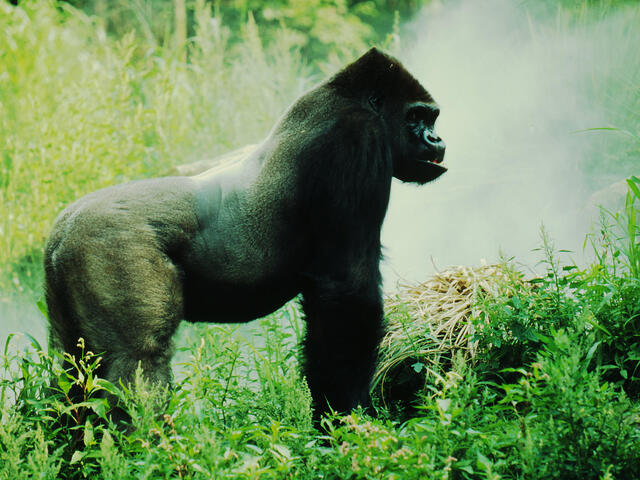Comparing Mountain Gorillas Vs Eastern Lowland Gorillas

Mountain gorillas and eastern lowland gorillas are two distinct subspecies of gorillas. Gorillas are the largest living primates, reaching heights between 1.25 and 1.8m (4 ft 1 in and 5 ft 11 in), weighing between 100 and 270 kg (220 and 600 lb) and arm spans up to 2.6 m (8 ft 6 in), depending on species and sex.
Mountain gorillas and eastern lowland gorillas have their own characteristics and in this guide, we explore the differences between these two species including their physical features, social structures, and where they can be found in the wild.
Mountain Gorillas Vs Eastern Lowland Gorillas: Physical Features (Size, Fur Color and Facial Features)
Mountain gorillas and eastern lowland gorillas have distinct physical features which sets them apart. Generally mountain gorillas are large in size, with males weighing up to 400 pounds and standing at around 5.6 feet tall fully upright. They have longer and thicker fur, which helps them withstand the colder temperatures in their mountainous habitats.
Usually, their fur color is darker ranging from black to dark brown.
The eastern lowland gorillas on the other hand are smaller with males weighing around 350 pounds and standing at about 5.3 feet tall. They have shorter and lighter-colored fur, which can range from brown to reddish brown. Also, their features differ with mountain gorillas having a broader and more pronounced forehead while eastern lowland gorillas have a more rounded and less prominent forehand.
These physical differences reflect the adaptations each subspecies has made to their specific environments and lifestyles. Understanding these distinctions can help you decide which gorilla species you wish to visit on a gorilla trekking experience in Africa and know where to find them.
Mountain Gorillas Vs Eastern Lowland Gorillas: Social Structures (Social dynamics within each gorilla species including their group sizes, hierarchy and mating behavior).
Mountain gorillas and eastern lowland gorillas have different social structures and behaviors.
Mountain gorillas live in relatively small groups called troops, consisting of one dominant silverback, several adult females and their offspring. The dominant silverback is the leader of the troop and is responsible for protecting and leading the troop. The females form strong bonds with the silverback and contribute to the care and upbringing of the young.
On the other hand, the Eastern Lowland Gorillas live in larger groups known as harems. These groups can consists of one dominant silverback, multiple adult females and their off spring. However, harems can also include subordinate males who are not yet dominant enough to have their own troop. The dominant silverback in a harem defends his females and territory from other males.
Between these two species, mating behaviors differ. Mountain gorillas have a polygynous mating system, where one dominant male mates with multiple females within his troop. This ensures the survival of his genes and increases his chances of passing his traits to the next generation. Also, eastern lowland gorillas have a polygynous mating system, but the dominant silverback may have to compete with other males for access to females.
Understanding these social dynamics is crucial for conservation efforts and ensuring the well-being of both mountain gorillas and eastern lowland gorillas in their habitats respectively.

Mountain Gorillas Vs Eastern Lowland Gorillas: Geographic Distribution
Also known as Gorilla beringei, mountain gorillas are found in the mountainous rainforests of Central Africa and are found in two populations, one in Bwindi Impenetrable National Park and the Virunga Mountains, which span the borders of Rwanda, Uganda and the Democratic Republic of Congo. They inhabit high-altitude forests and bamboo thickets in this region.
Eastern lowland gorillas on the other hand are found in the eastern Democratic Republic of Congo in Virunga National Park. Primarily, they inhabit lowland tropical rainforests and swamp areas.
The geographical distribution of mountain gorillas and lowland gorillas is an important consideration for conservation efforts. The Virunga Mountains, where mountain gorillas are found are protected by national parks and conservation organization. However, the eastern lowland gorillas face more challenges due to the ongoing conflict in Democratic Republic of Congo.
Efforts are being made by several conservation organizations and peacemakers to protect their habitats and ensure their survival in the face of these challenges.
Mountain Gorillas Vs Lowland Gorillas: Conservation Status
The conservation status of both mountain gorillas and lowland gorillas differs due to their geographical distribution and the threats they face in their natural habitats. Mountain gorillas are listed as endangered by the International Union for Conservation of Nature (IUCN), with a population of approximately 1,064 individuals. There main threats include habitat loss, poaching, and civil unrest in the region.
The eastern lowland gorillas on the other hand are listed as critically endangered by the IUCN, with a population of around 3,800 individuals. They face similar threats as mountain gorillas, such as habitat loss and poaching, but the ongoing conflict in the Democratic Republic of Congo act as a challenge to their conservation.
The conservation efforts for both gorilla species involve establishing protected areas, implementing anti-poaching measures, and promoting sustainable tourism. Conservation organizations like Dian Fossey Gorilla Fund and the Gorilla Organization work tirelessly to protect these endangered creatures and their habitats.
Understanding the conservation status and threats faced by mountain gorillas and eastern lowland gorillas is vital for raising awareness and supporting conservation initiatives. By taking action and supporting these efforts, we all contribute to ensuring the survival of these incredible species for future generations.
